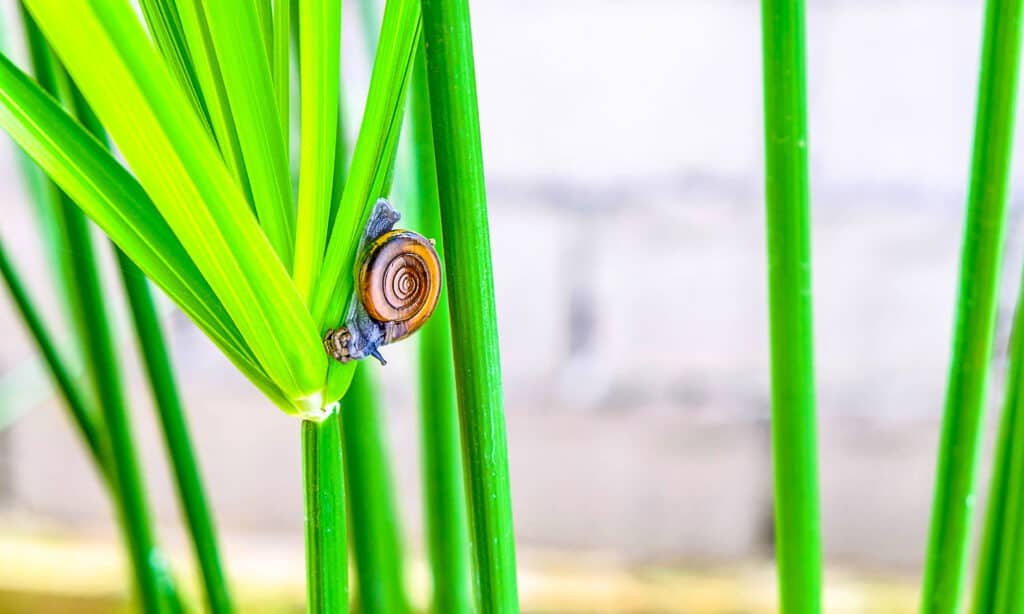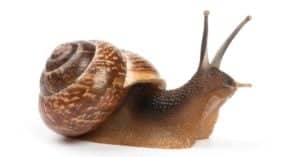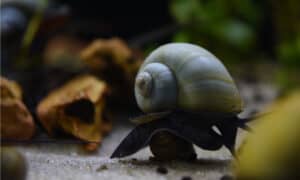Snails, despite being famous for their sluggishness, are very interesting animals to study. For instance, even though they are shell animals with no apparent hole for waste discharge, they poop. But there are various misconceptions relating to this part of their life.
Do you have a snail as a pet, or are you hoping to keep one? Read this post to find out all you’ve ever wanted to know about snail poop.
How Do Snails Release Their Poop?

Every snail has an anus through which it passes out its poop.
©IspasI/Shutterstock.com
Unlike slugs, snails have shells protecting their soft but slippery bodies. All the internal organs of a snail exist only inside the shell. One of such organs or part of the snail is the anus. Yes, you read that right. Every snail has an anus through which it passes out its excrement.
The position and structure of the protective shell of snails are designed in such a way that they only have one central opening. This opening is for protrusion of the head for basic survival activities such as eating, interaction with the environment, and others. The foot and tail also come out of this opening for movement.
However, there are common misconceptions about where and how snails release their poop. An example is the idea that snails release waste from their mouth because there is no other opening in the shell. But a study shows that there is, indeed, another opening in the shell. This opening is known as the breathing hole.
The breathing hole supplies the lungs with air. The anus is also on this same side. So apart from its usage for respiratory purposes, the breathing hole also serves as an outlet for passing the snail poop out of the body. The bottom line is:
- Snails have internal organs, including an anus that secretes digestive waste inside the shell, not outside.
- The poop, after release, passes through the breathing hole and comes out from the side of the central opening of the shell.
So while there are animals that don’t poop, snails are not one of them. Although they don’t have an external anus, they have one inside their shell. But what does this poop really look like? Let’s find out!
What Does Snail Poop Look Like?

When fresh, snail poop maintains a smooth texture and is moist.
©KanphotoSS/Shutterstock.com
All snail species pass out the same poop shape— a rope-like shape. When newly released, the poop is long and looks like a small rope. But when it dries up, it changes shape to a more constricted C-shape. It also breaks into smaller pieces in its dry state.
The texture of the poop could be smooth and moist or hard. When initially passed out from the breathing hole, the snail digestive waste maintains a smooth texture and is moist. They are usually tiny when you see them on leaves or snail pathways. But as they get dry, they lose this smooth texture; they further harden and get smaller in size.
The color of the poop is the most exciting part of identifying the digestive waste of snails. Snail poop has no definite color. The color it takes usually depends mainly on two factors. They are:
- The Color Of The Shell
One incredible fact about snails is that there are over 40,000 species in existence. Shell color varies from species to species and this makes the poop color to vary too.
- The Diet Of The Snail
Snails have a simple metabolic process. Hence, the color of poop often reflects the diet. For instance, a snail that has a leafy diet will most likely pass out green poop. But this color can change based on what they eat. If a snail should eat watermelon, for instance, it will most likely pass out red poop.
Knowing the poop shape, texture, and color of snail poop can help you identify it if you ever come across one in a garden. These three features affect the look of the poop which change over time.
What Are The Uses Of Snail Poop?

The poop of a snail serves as an excellent fertilizer for plants.
©Narong Khueankaew/Shutterstock.com
Snail poop does have its uses in the garden. Snail digestive waste contains the three primary nutrients needed by many plants which are Nitrogen, Phosphorus, and Potassium. These 3 nutrients are the main product of a typical fertilizer.
One factor that increases the usefulness of snail poop in gardens is its frequency. The truth is that snails poop a lot. They continue to eat and excrete as long as food is accessible to them. The volume of poop can be useful in the farm to help adequately fertilize the soil. But this might come at a cost considering the fact that these mollusks will keep eating the green leaves of the garden.
Nevertheless, it is wise to leave snail poop in the soil to enhance the earth’s nutrients. The poop does not bring any harm to plants. But is that the case for humans? Let’s see.
Is Snail Poop Harmful?
Fortunately, snail poop contains no toxic substance that can harm humans. Also, these mollusks do not carry any diseases infectious to man. This means that snail digestive waste is neither poisonous nor harmful. Their non-existent health risk and simple diet are some of the main reasons many keep these animals as pets.
The photo featured at the top of this post is © Zebra-Studio/Shutterstock.com
Thank you for reading! Have some feedback for us? Contact the AZ Animals editorial team.







